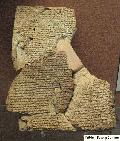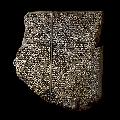Illustrated Bible History
Ancient Babylonian Tablets - Cuneiform Tablets

|
Cuneiform Tablet With Atrahasis Epic
|
|
Babylonian cuneiform tablet of about 17th century BC with the Atrahasis epic. From a specimen in the British Museum. |

|
Deluge Tablet
|
|
This Babylonian deluge tablet written in ancient cuneiform contains similar stories about a deluge like the Biblical event of the flood of Noah. The babylonian stories date back to around 1700 BC. The actual flood of Noah was much older, around 2800 BC. |

|
Babylonian Flood Tablet
|
|
The Flood Tablet, relating part of the Epic of Gilgamesh. The British Museum says: The Assyrian King Ashurbanipal (reigned 669-631 BC) collected a library of thousands of cuneiform tablets in his palace at Nineveh. It included letters, legal texts, lists of people, animals and goods, and a wealth of scientific information, as well as myths and legends.
The best known of these was the story of Gilgamesh, a legendary ruler of Uruk, and his search for immortality. The Epic of Gilgamesh is a huge work, the longest piece of literature in Akkadian (the language of Babylonia and Assyria). It was known across the ancient Near East, with versions also found at Hattusas (capital of the Hittites), Emar in Syria and Megiddo in the Levant.
This, the eleventh tablet of the Epic, describes the meeting of Gilgamesh with Utnapishtim. Like Noah in the Hebrew Bible, Utnapishtim had been forewarned of a plan by the gods to send a great flood. He built a boat and loaded it with all his precious possessions, his kith and kin, domesticated and wild animals and skilled craftsmen of every kind.
Utnapishtim survived the flood for six days while mankind was destroyed, before landing on a mountain called Nimush. He released a dove and a swallow but they did not find dry land to rest on, and returned. Finally a raven that he released did not return, showing that the waters must have receded.
This Assyrian version of the Old Testament flood story was identified in 1872 by George Smith, an assistant in The British Museum. On reading the text he ... jumped up and rushed about the room in a great state of excitement, and, to the astonishment of those present, began to undress himself. |
| 


